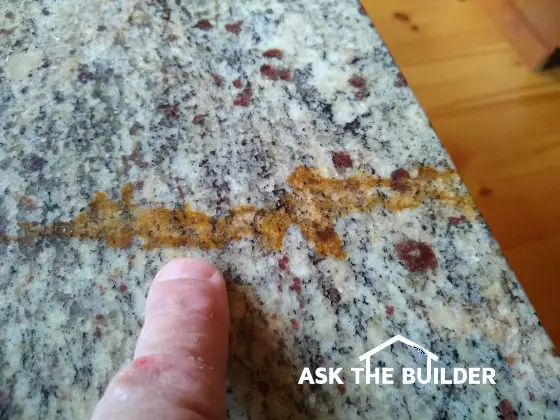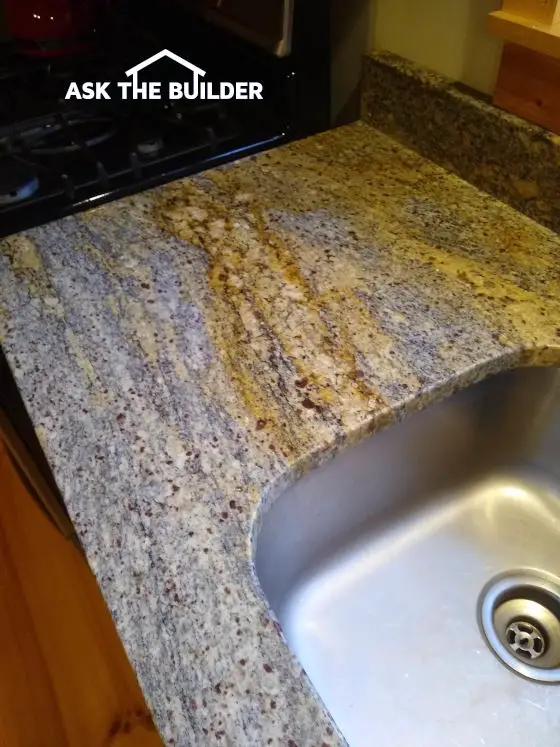Natural Discoloration Stains in Granite Countertops & Drywall Joint Banding

Natural Discoloration Stains in Granite Countertops | You’re looking at an iron-oxide (rust) stain in a granite countertop that could be millions of years old. In my opinion, it’s not a defect. (C) Copyright 2019 Tim Carter
Natural Discoloration Stains in Granite Countertops
QUESTION #1: Tim, we just moved into an existing home that’s got granite countertops. When we looked at the house there were cleverly placed trivets in certain places. I’ve come to discover they were hiding what appears to be rust stains deep in the granite but I really can’t say for certain. Is this natural? Can anything be done to remove or lessen their appearance? Would you accept granite that looks like this? Constance P., Fresno, CA
While I’m not a full-time hard-rock geologist, my house happens to rest upon the Meredith Porphyritic Granite, thought by many to be the most gorgeous rock in all of New England. I did major in geology in college and am attracted to granite for a host of reasons. It’s not only a gorgeous rock, but it’s also one of the most durable natural stones you can buy.
Random discoloration in some granite is normal. There are many reasons why it happens. Many people think the discoloration adds character and makes their countertops one-of-a-kind.
It’s important to realize that giant formations of granite can have cracks throughout the rock. If the granite is working it’s way to the surface over a million years or so, hot mineral-rich groundwater can be forced at high pressure into the tiniest cracks in the rock. This may explain how the discoloration occurred.
Another key point is the rust stains may be just a surface imperfection created by a happy accident attributed to the previous homeowner. Something made from iron may have gotten wet and the legs or bottom of the object as it sat on the granite left behind the rust.
You can do a small test to see if you can remove the rust stain. I’d start with oxalic acid. This product comes in crystals and is readily available online. Mix it according to the package instructions and pay close attention to all the warnings on the label. Apply just one drop with a cotton swab to the stain. Allow the acid to work for ten or fifteen minutes. If the droplet soaks in, add another drop on top until you have a tiny standing pool of solution on the granite no bigger than the eraser on a pencil.
At the end of the waiting period, take a clean cotton swab and try to suck up the droplet of acid you put on the counter. If the tip of the new cotton swab goes from white to brown then you know you’re removing the rust and it might have been a surface deposit.
Rinse the spot with clear water at least two times. Use a clean rag and dry the granite. It’s now time to check for surface damage.

You want to use a flashlight or smartphone light and check to see if the acid harmed the gloss finish of the granite. The odds are there will be no damage, but check to make certain. I’d then wait for a week to see if there’s any change in color to the spot where you placed the drop of acid.
If there’s no change in color, then you can begin to do the same process to try to remove the surface rust stain. Take your time and don’t go crazy with the acid solution. Use no less than one gallon of common sense when working with it.
Drywall Joint Banding
QUESTION #2: Hey Tim, I’m having a robust debate with my painter. I have a room with all new drywall and it’s not been skimmed coated so the white joint compound stands out next to the paper face of the drywall. In my old house, you could see at night time where each taped seam was as well as the joint compound covering the fasteners. What’s odd is the wall was perfectly smooth. My painter says this is not going to happen this time. Should I trust him? Brian M., Richmond, VA
Ah, the mystery of drywall joint banding! Look closely at the paper facing of drywall and the sanded joint compound and you should be able to understand exactly why your wall in the old house was not one texture when the low-angle light hits it from indoor light fixtures.

This small section of wall has just about every drywall finish challenge in it: flat and tapered seams, inside and outside corners and an archway! Photo credit: Tim Carter
Your painter may be trustworthy if he intends to apply a primer and/or paint-primer mixture that has two mission-critical ingredients. The paint or primer must have a sealer that takes care of the porosity issue between the joint compound and the drywall paper. Another key point is the primer or paint/primer must have some heavy-body pigments to even out the texture between the smooth joint compound and the coarser paper facing.
There are special drywall primers made that have these ingredients. I’ve also seen at the Altar of Saving Time a finish paint product that claims it can do everything you want to be done with just one coat not requiring a primer. I’ve not yet tested this product on new drywall, but it’s entirely possible a paint manufacturer has developed a product that eliminates the need for the special drywall primer. You can get one quart of this and paint one wall as a test.
Column 1325